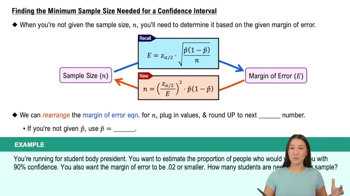In Exercise 37, does it seem likely that the population mean could be greater than \$70? Explain.
Table of contents
- 1. Intro to Stats and Collecting Data1h 14m
- 2. Describing Data with Tables and Graphs1h 55m
- 3. Describing Data Numerically2h 5m
- 4. Probability2h 16m
- 5. Binomial Distribution & Discrete Random Variables3h 6m
- 6. Normal Distribution and Continuous Random Variables2h 11m
- 7. Sampling Distributions & Confidence Intervals: Mean3h 23m
- Sampling Distribution of the Sample Mean and Central Limit Theorem19m
- Distribution of Sample Mean - Excel23m
- Introduction to Confidence Intervals15m
- Confidence Intervals for Population Mean1h 18m
- Determining the Minimum Sample Size Required12m
- Finding Probabilities and T Critical Values - Excel28m
- Confidence Intervals for Population Means - Excel25m
- 8. Sampling Distributions & Confidence Intervals: Proportion1h 25m
- 9. Hypothesis Testing for One Sample3h 57m
- 10. Hypothesis Testing for Two Samples4h 50m
- Two Proportions1h 13m
- Two Proportions Hypothesis Test - Excel28m
- Two Means - Unknown, Unequal Variance1h 3m
- Two Means - Unknown Variances Hypothesis Test - Excel12m
- Two Means - Unknown, Equal Variance15m
- Two Means - Unknown, Equal Variances Hypothesis Test - Excel9m
- Two Means - Known Variance12m
- Two Means - Sigma Known Hypothesis Test - Excel21m
- Two Means - Matched Pairs (Dependent Samples)42m
- Matched Pairs Hypothesis Test - Excel12m
- 11. Correlation1h 24m
- 12. Regression1h 50m
- 13. Chi-Square Tests & Goodness of Fit2h 21m
- 14. ANOVA1h 57m
7. Sampling Distributions & Confidence Intervals: Mean
Confidence Intervals for Population Mean
Problem 6.1.48
Textbook Question
Determining a Minimum Sample Size Determine the minimum sample size required when you want to be 99% confident that the sample mean is within two units of the population mean and σ = 1.4. Assume the population is normally distributed.
 Verified step by step guidance
Verified step by step guidance1
Identify the formula for determining the minimum sample size for estimating a population mean: , where is the critical z-value, is the population standard deviation, and is the margin of error.
Determine the critical z-value for a 99% confidence level. Since the confidence level is 99%, the significance level is 0.01, and is 0.005. Use a z-table or statistical software to find the z-value corresponding to a cumulative probability of 0.995.
Substitute the given values into the formula. Here, = 1.4 and = 2. The formula becomes: .
Simplify the expression inside the parentheses by multiplying the critical z-value by the standard deviation and dividing by the margin of error.
Square the result from the previous step to calculate the minimum sample size. If the result is not a whole number, always round up to the nearest integer, as sample size must be an integer.
 Verified video answer for a similar problem:
Verified video answer for a similar problem:This video solution was recommended by our tutors as helpful for the problem above
Video duration:
2mPlay a video:
Was this helpful?
Key Concepts
Here are the essential concepts you must grasp in order to answer the question correctly.
Sample Size Determination
Sample size determination is the process of calculating the number of observations needed in a sample to achieve a desired level of confidence and precision. It is crucial in statistics to ensure that the sample accurately reflects the population, allowing for valid inferences. The formula often used involves the desired confidence level, the population standard deviation, and the margin of error.
Recommended video:
Guided course

Coefficient of Determination
Confidence Level
The confidence level represents the probability that the sample mean will fall within a specified range of the population mean. In this case, a 99% confidence level indicates that if we were to take many samples, 99% of the time, the sample mean would be within two units of the true population mean. This concept is essential for understanding the reliability of the sample estimates.
Recommended video:

Introduction to Confidence Intervals
Margin of Error
The margin of error is the range within which the true population parameter is expected to lie, given a certain level of confidence. In this scenario, a margin of error of two units means that the sample mean should be within two units of the population mean. This concept is vital for determining how precise the sample estimate needs to be in relation to the population parameter.
Recommended video:

Finding the Minimum Sample Size Needed for a Confidence Interval

 4:48m
4:48mWatch next
Master Population Standard Deviation Known with a bite sized video explanation from Patrick
Start learningRelated Videos
Related Practice
Textbook Question
35
views
